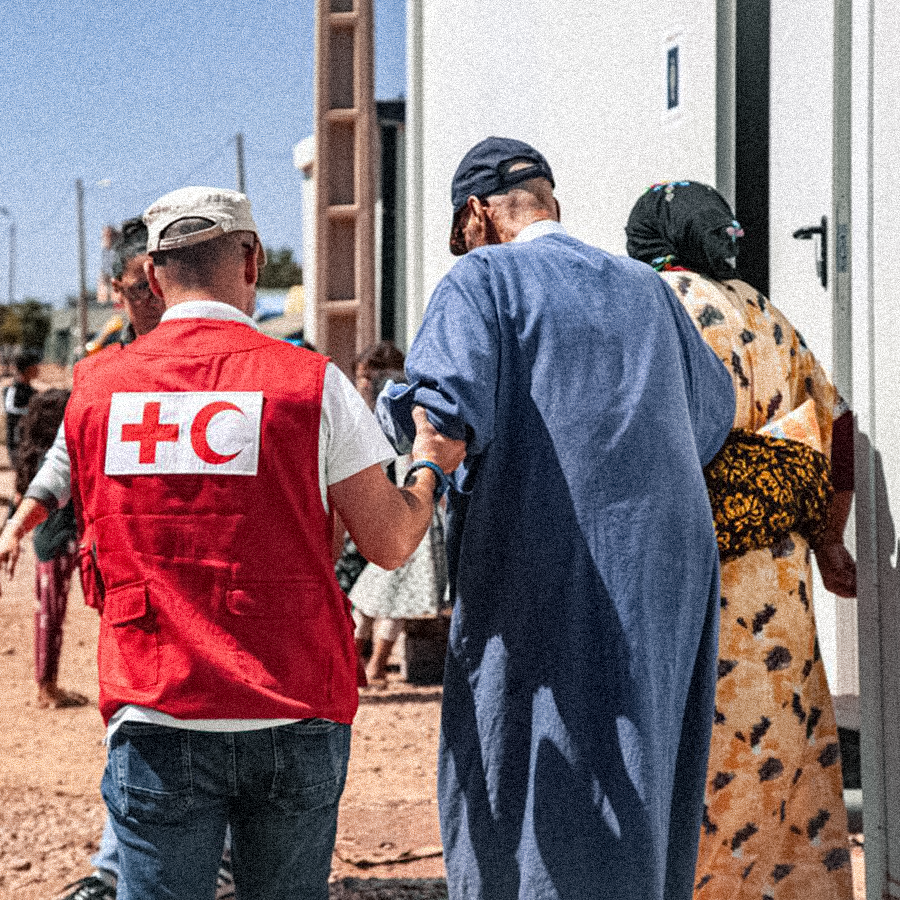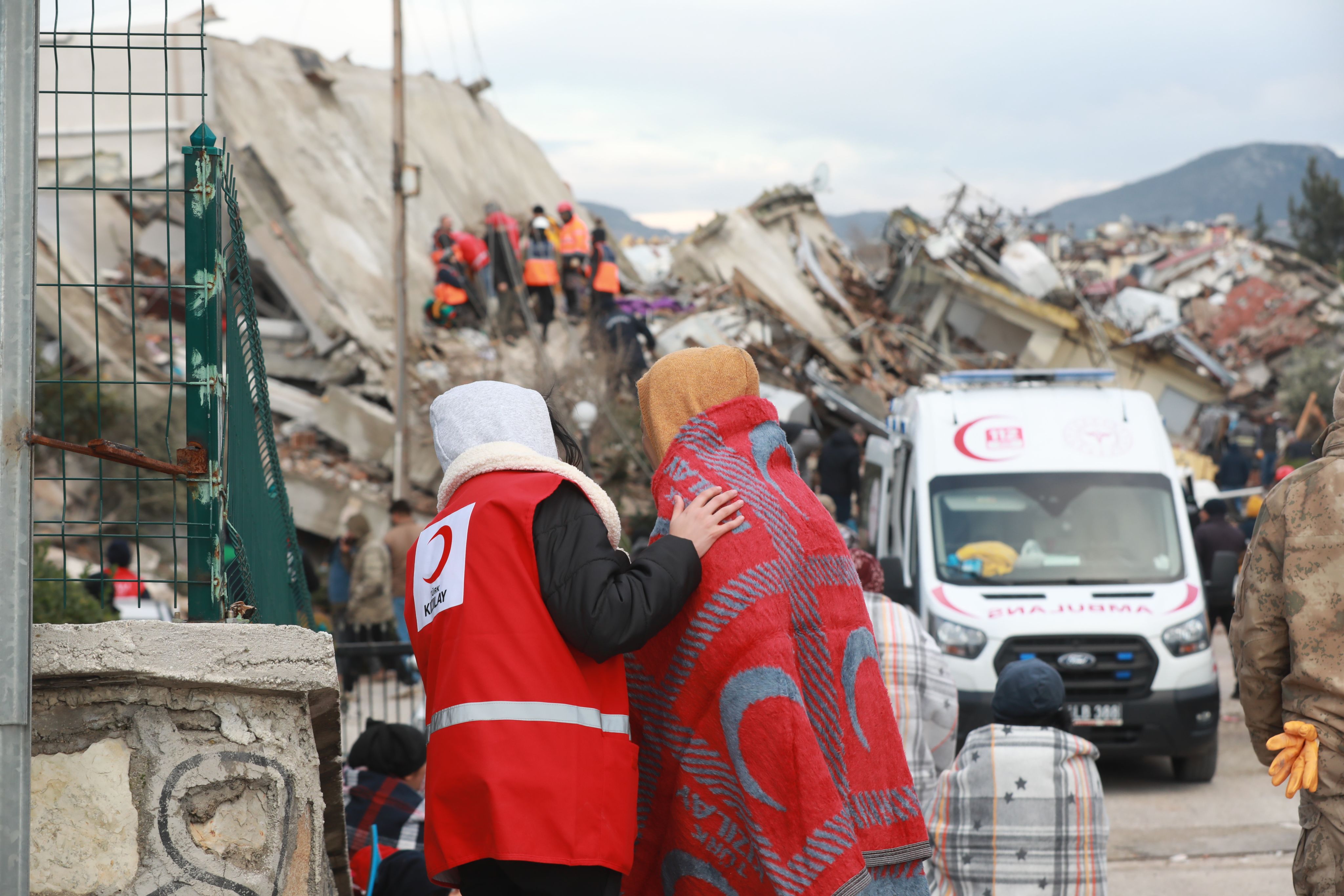IFRC DISASTER
RESPONSE
EMERGENCY
FUND
2024 ANNUAL REPORT

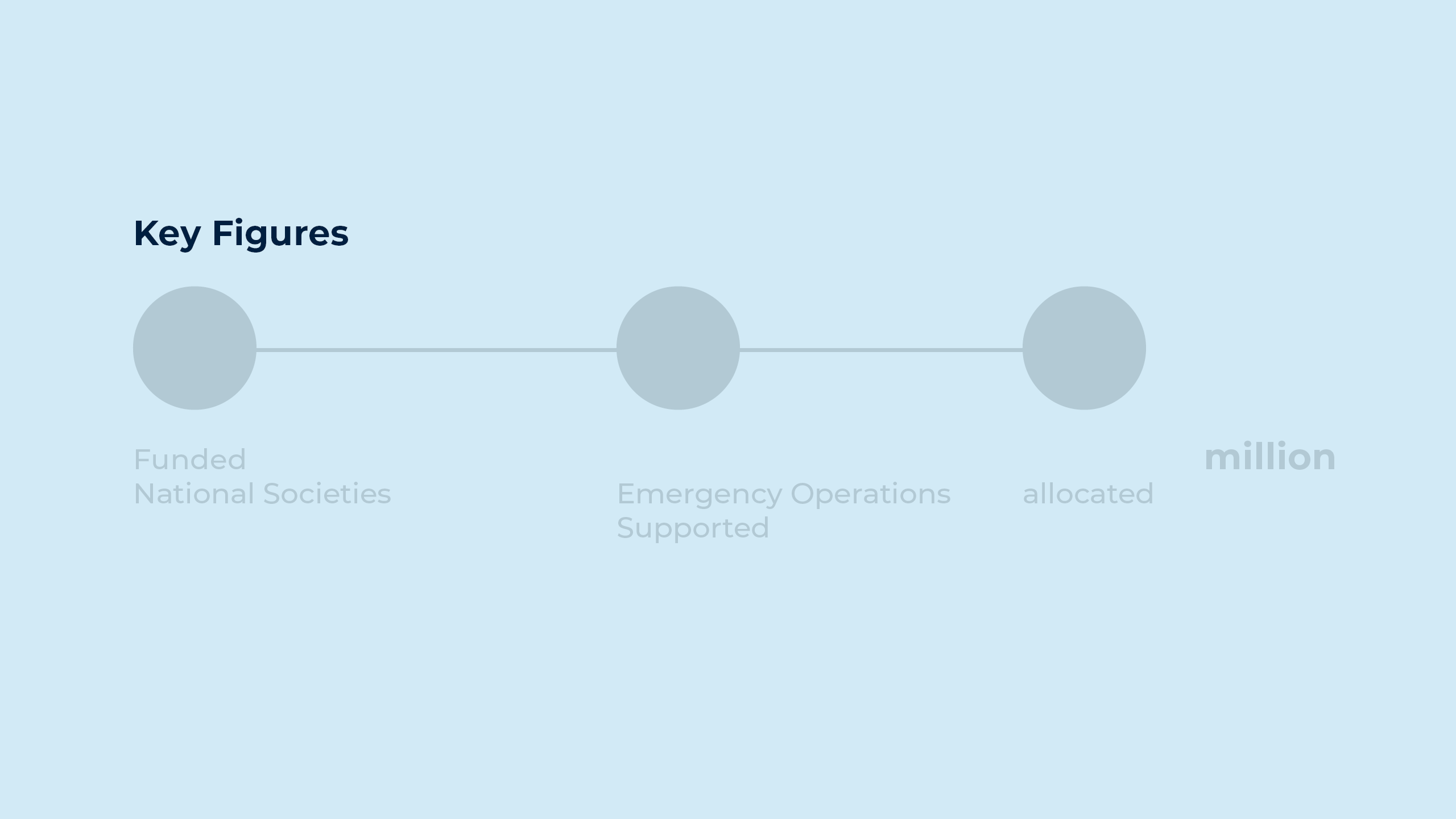




The International Federation of Red Cross and Red Crescent Societies (IFRC) is the world’s largest humanitarian network. With a presence in over 191 countries and more than 16 million volunteers, we support local Red Cross and Red Crescent actions to serve humanity
The IFRC acts before, during, and after disasters and health emergencies to meet the needs of and improve the lives of vulnerable people.
Our strength lies in our volunteers, our community-based expertise, and our commitment to neutrality and independence.
Guided by Strategy 2030, our mission is to build healthy, safe, and resilient communities, reduce vulnerabilities, and promote peace worldwide to adapt to emerging 21st-century challenges.
“In the face of escalating global crises,
IFRC remains committed to alleviating human suffering, guided by our enduring Fundamental Principles and mission. At the heart of our response is the IFRC-DREF, a pivotal instrument enabling National Societies on the ground to act swiftly and effectively in times of need. We are innovatively expanding our capacity through IFRC-DREF Insurance. The potential of IFRC-DREF Insurance is immense, increasing our capacity to reach up to 6 million more people vulnerable to natural hazards. IFRC-DREF stands out in its commitment to channeling support directly to local actors. While the global average of humanitarian funds directly allocated to local actors is around 4.5% annually, an impressive 76.5% of IFRC-DREF’s allocations are directly transferred to National Societies. This approach ensures aid is efficient, effective, and empowers local actors best positioned to understand and meet community needs."
Jagan Chapagain
IFRC Secretary General






Efficient. Fast. Transparent. Localized.
The IFRC Disaster Response Emergency Fund (IFRC-DREF) is one of the world’s oldest humanitarian pooled funds for small to medium-scale emergencies. It is a fast, transparent, and localized way to channel funds directly to frontline responders—before or after disaster strikes.
HOW DOES IFRC-DREF WORK?
The IFRC-DREF quickly provides funding for early action and immediate disaster response. By allocating funds directly to National Societies (NS) rooted in local communities, the IFRC-DREF capitalizes on their extensive knowledge of local conditions.
It is open to all 191 National Societies that submit funding applications and plans of action.
Rapid Response Funding
IFRC-DREF requests can be:
- Approved within 24 hours
- Disbursed in less than 72 hours
HOW IS IT FUNDED?
IFRC-DREF is a pooled fund supported by various donors, which allows fast, needs-based funding decisions closely aligned with humanitarian needs.
In 2022, the IFRC-DREF Council was established to enhance governance and provide strategic guidance. This independent advisory body is dedicated to offering strategic insight and advice on the fund's management and performance. Learn more about IFRC-DREF council here.
IFRC-DREF Council Members
- High-level representatives from major donor governments
- Corresponding National Societies
- Selected Experts
Want to support IFRC-DREF?
If you are interested in becoming a donor for IFRC-DREF, please contact:
Ivana Mrdja
Manager, Public Sector Partnerships, Strategic Partnerships and Resource Mobilisation Department
(ivana.mrdja@ifrc.org).
ONE FUND, TWO PILLARS
IFRC-DREF uniquely supports both anticipatory action and disaster response within a single fund.
Response Pillar
IFRC-DREF responds to small and medium disasters and acts as a bridge fund while additional resources are raised through emergency appeals, ensuring timely aid to the most vulnerable people.
Anticipatory Pillar
IFRC-DREF supports early funding to save more lives and livelihoods, minimize impact, and alleviate suffering by acting before hazards strike. This is facilitated by a mechanism wherein financial resources are pre-agreed and released automatically once a predetermined trigger is reached, ensuring timely and effective early action. IFRC aims to allocate 25% of IFRC-DREF funding by 2025 to the Anticipatory Pillar. In 2024, CHF 9.3 million (10.8% of the fund) was allocated through the Anticipatory Pillar.
IFRC INSURANCE
In partnership with Aon and the Centre for Disaster Protection, IFRC launched a first-of-its-kind insurance policy to protect IFRC-DREF from funding gaps.
IFRC-DREF Insurance is an innovative finance mechanism that leverages the private sector's power to increase stretched government donor contributions.
How it works?
Instead of providing money to fund disaster responses as a traditional grant, donors can pay the insurance premium. This stretches the value of their contributions and transfers the risk to the private sector if IFRC-DREF funding requests for natural hazards exceed available resources.
While direct donor contributions to IFRC-DREF will always remain necessary, IFRC-DREF Insurance provides a contingency financing layer. It ensures the IFRC network can be there for people affected by disasters quickly, efficiently, and reliably.
Access more information through the official IFRC-DREF website.







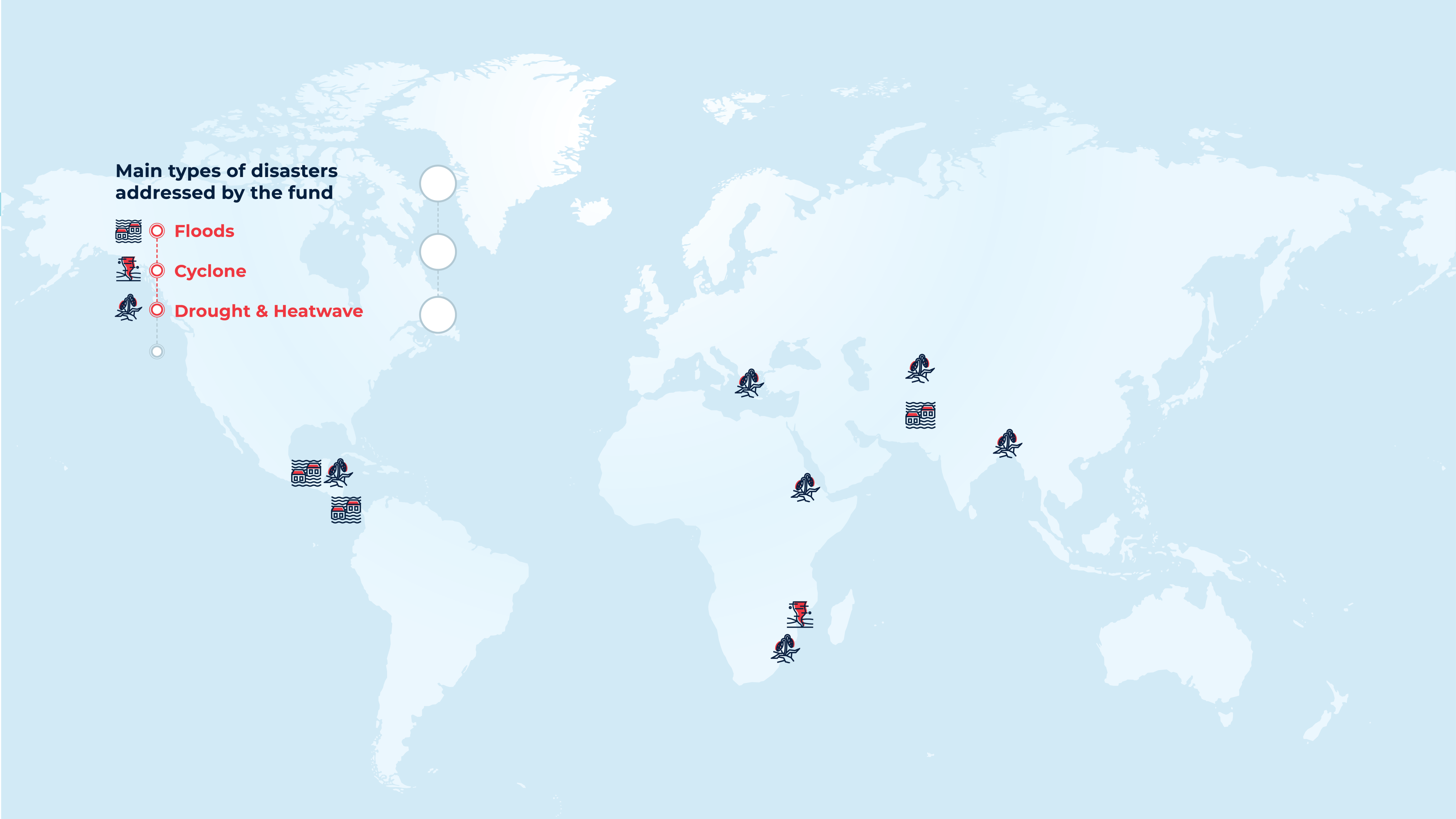












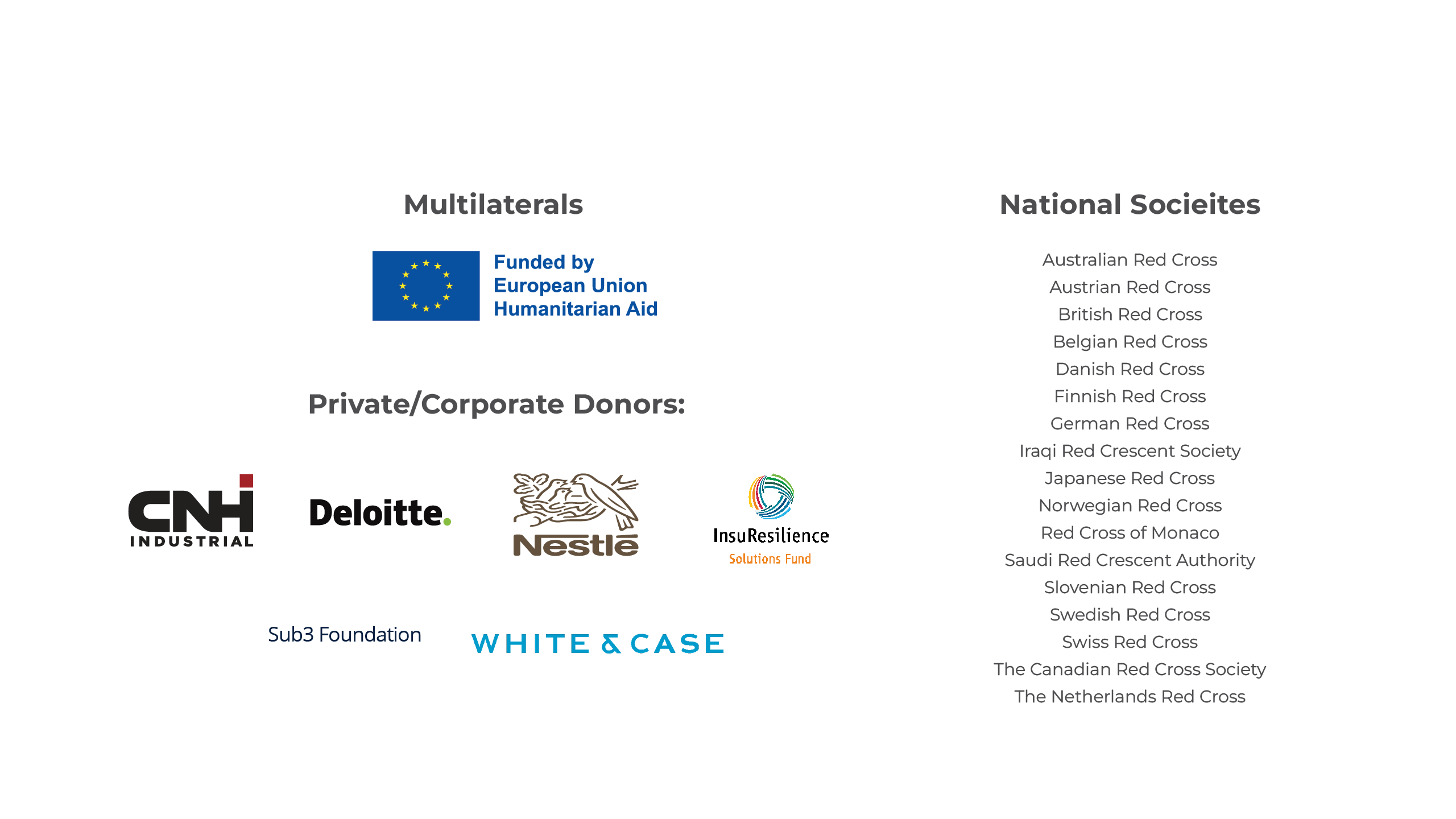

Growing With Our Donors
In 2024, IFRC-DREF received CHF 91.6 million, including CHF 77 million from voluntary contributions and CHF 14.4 million from insurance payouts, a significant increase from CHF 17.1 million in 2019. Private sector contributions surged from CHF 0.6 million in 2019 to CHF 24 million in 2024, while government contributions rose sixfold, with the IFRC-DREF Council expanding to 14 government donors and DG ECHO.
The CHF 2.9 million Swiss Francs in insurance premiums covered up to CHF 14.4 million Swiss Francs for natural hazards in ODA countries. The insurance was activated for the first time in September 2024, triggered by Super Typhoon Yagi, and paid out CHF 14.4 million Swiss Francs across 31 operations, reaching an additional 1.6 million beneficiaries.
In 2024, the IFRC-DREF Council grew to 15 members, adding the Austrian Government and Austrian Red Cross, Danish Government and Danish Red Cross, Spanish Government and Spanish Red Cross. The 4th IFRC-DREF Pledging Conference saw over 75 participants and 22 pledging statements.
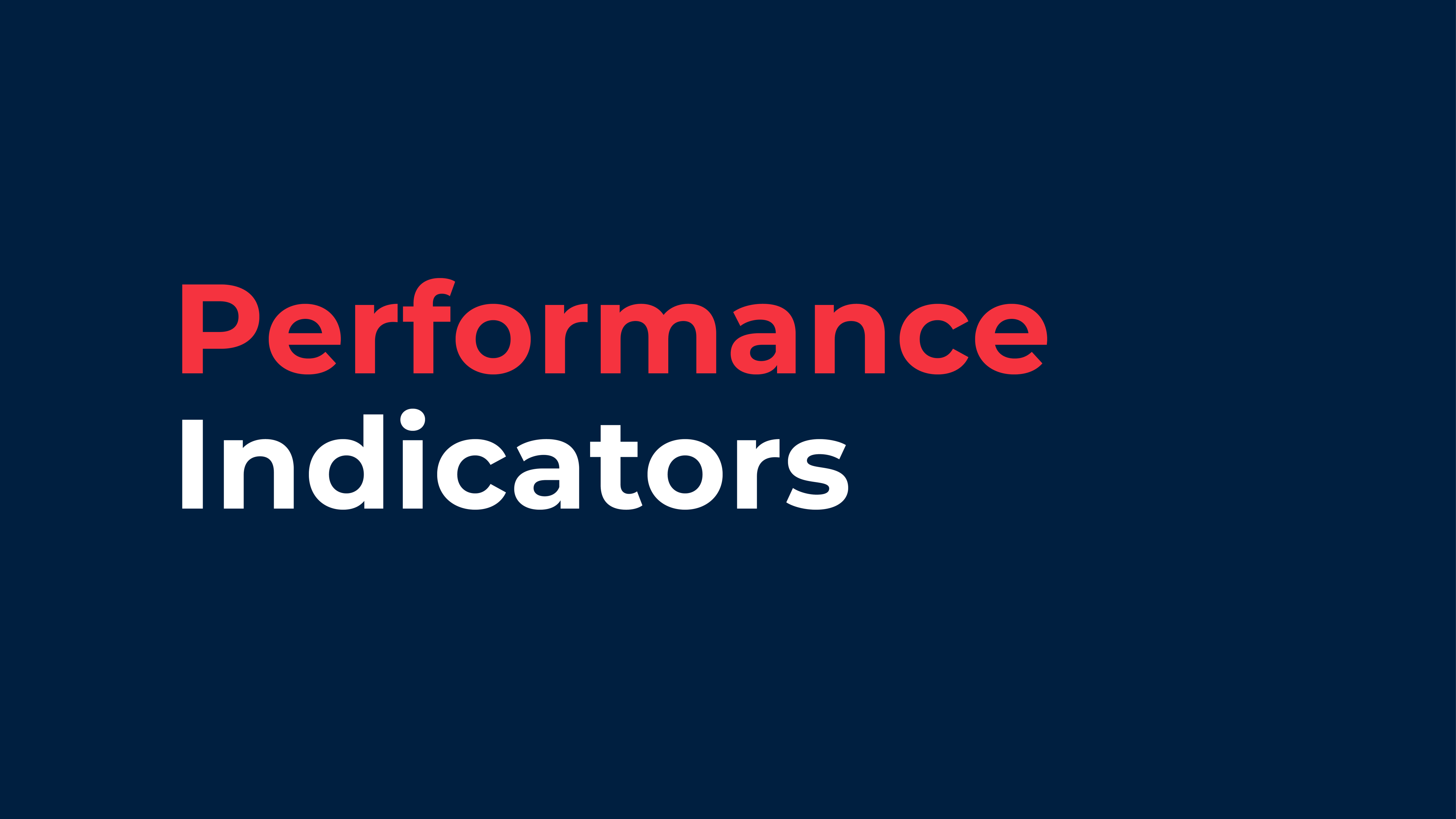


Progress Against Outcomes








Enabling Local Action – Enough Funding as Direct as Possible
Key Achievements
- Advance Payment Request Modality is designed for quicker initial fund disbursement (25% within 24 hours).
- A two-step review process was implemented to balance speed and quality of IFRC-DREF applications.
- A 3% cap on non-ODA country allocations was introduced to improve equity; only 2.3% of funds went to such countries in 2024.
- Loan-to-grant shift for Yellow/Orange EA funding adopted for transparency and sustainability.
- The Digital Annual Report has been launched, increasing stakeholder engagement and access.
- The Localisation Study with BRC (December 2024) confirmed that as of data that was available for 2023, 76.5% of funding went directly to local actors and highlighted gaps and solutions for locally led responses.
- PGI integration in operations improved: 71% of operations included PGI components.
- Live Dashboard enhancements improved usability and donor visibility.
- Insurance payout of CHF 14.4 million triggered for the first time, supporting 31 operations and 1.6 million people.
- Successful pledging conference ("45 Years of Impact") with increased visibility and donor participation.
- Monthly newsletter growth: 400+ subscribers and improvements based on a satisfaction survey.
- Media visibility increased, especially around the insurance mechanism.
- Collaboration with Anticipation Hub strengthened thought leadership and practice alignment.
Saving More Lives, Anticipating Crisis, and Acting Earlier
Key Achievements
- Imminent IFRC-DREF adjusted to simplify application: CHF 75,000 lump sum for rapid-onset disasters only.
- EAPs now activatable twice before requiring revisions, increasing flexibility and efficiency.
- Protocol submission streamlined via a joint IFRC-DREF email channel.
- Validation Committee expanded to include health/migration experts and National Society peers.
- Capacity building: 39 national societies were trained, 180+ people reached, and regional and language-specific training was held.
- 17 webinars and 14 briefings reached over 970 participants.
- EAP criteria for non-weather hazards are pending, with finalization planned for 2025.
Increasing the Value of IFRC-DREF in Protracted, Slow Onset and Complex Events
Key Achievements
- Drought IFRC-DREF Guidance finalized and piloted with allocations to 9 countries (CHF 4.88 million), representing 67% of slow onset allocations.
- Slow Onset IFRC-DREF Modality rolled out and disseminated through internal engagements.
- Protracted Crises Study conducted with actionable recommendations and adjusted thresholds and timeframes:
Orange IFRC-DREFs now up to 9 months and CHF 1 million.
Crisis-specific multi-country caps were introduced to ensure sustainability.
- Population movement is recognized as a slow/protracted crisis with potential for anticipatory action.
Lean, Efficient Fund
Key Achievements
- KPIs and Risk Registers are updated regularly, with regional input.
- Quarterly Compliance Reviews conducted and shared.
- Internal audit (Asia-Pacific) and DG ECHO audit in progress.
- A financial review framework was developed for the National Society fund tracking.
- Linking compliance data with IFRC risk tools supports informed decision-making.
Increase Support for Strengthening National Societies
Key Achievements
- Revised IFRC-DREF guidelines and training materials produced and disseminated.
- 7 national-level trainings (Response Pillar) and 7 (Anticipatory Pillar) conducted.
- Webinars and briefings reached 970 people; tools translated to French and Spanish.
- Simulation with Hellenic Red Cross successfully tested Heatwave sEAP.
- Peer Exchange Program launched, supporting interregional learning and IFRC-DREF surge capacity.
- Input into the revised Forecast-based Financing Manual and PGI toolkit enhanced technical resources.
National Society Ownership and Trust
Key Achievements
- Feedback process launched (survey, online tool, in-person sessions):
33 NS staff/volunteers and 34 IFRC staff responded.
High scores on targeting and coordination; identified needs: simplify procurement/reporting and enhance community participation.
- 11 Operational Reviews conducted (planned 15 extended to 2025), covering 30+ operations across 28 NSs.
- Reviews focused on:
Efficiency and volunteer engagement
Impact reporting
Simplified logistics
Digital transformation
Coordination and early action
- Notable Reviews: EAP Activations, Armenia Case Study, Localization Review with BRC, Epidemic & Dengue Preparedness, and SDC-commissioned external IFRC-DREF review.
Stories

AFRICA
Africa
“Volunteers went from shelter to shelter to see how we were doing. They taught us how to keep our shelters clean and how to prevent diseases such as cholera. But most importantly, they listened to us when we talked about the hardships we had been through and all the loved ones we had lost.”
— Madi, an internally displaced person, on the services she received from Cameroon Red Cross with IFRC-DREF support.
In 2024, Africa continued to be the most engaged region with IFRC-DREF, addressing increasingly complex crises through both grants and loans. Unlike 2023, allocations between the two remained balanced, reflecting more strategic transitions from anticipation to response, as seen in Zambia, South Sudan, and Mali. Operations frequently evolved from Imminent IFRC-DREF to full Emergency Appeals, reinforcing IFRC-DREF’s essential role as a rapid bridge in emergencies. Droughts, floods, and disease outbreaks like those in Tanzania and Mozambique received critical early support for assessments and coordination.
2024 also marked a substantial rise in support for slow-onset disasters and epidemics, with epidemic allocations rising by 34 percent from 2023 and more than 60 percent from 2022. To address operational challenges and quality concerns, the region implemented the Africa IFRC-DREF Improvement Plan, which included targeted training for six National Societies and four Partner National Societies. Simulations and anticipatory action briefings helped build readiness, especially ahead of El Niño-related droughts. Operational reviews emphasized the need for stronger logistics, financial systems, and data-driven approaches, guiding future improvements and sustainability efforts across the continent.
Highlights:
- 34% increase in epidemic-related IFRC-DREF support vs. 2023
- Piloting of Drought IFRC-DREF modality in three countries
- Strategic transitions from anticipation to Emergency Appeals
- Africa IFRC-DREF Improvement Plan launched with capacity-building for 6 NSs
- Stronger focus on slow-onset crises (53% of 2024 allocations)
AMERICAS
Americas
The Americas region saw a continued upward trend in IFRC-DREF usage in 2024, with 33 operations funded at CHF 12.1 million—up from 26 in 2023 and 25 in 2022. The IFRC-DREF supported over 260,000 people across both response and anticipatory action pillars. Major highlights included the approval of the region’s first full Early Action Protocols for drought in Colombia and El Salvador, underscoring the growing momentum around anticipatory frameworks in Latin America.
Noteworthy response operations included back-to-back hurricanes in Cuba, with CHF 1.4 million allocated to support over 15,000 people. Large-scale events in Brazil and the Caribbean also triggered substantial loans, enabling swift interventions. Beyond emergency response, 2024 emphasized capacity strengthening: IFRC-DREF training reached 72 volunteers and staff, and two anticipatory training sessions brought in nearly 50 participants from four National Societies. As demand for support rises, the region is proving the IFRC-DREF’s strategic value in enabling both fast response and proactive resilience-building.
Highlights:
- 33 operations, CHF 12.1 million in total allocations
- First full EAPs approved in Colombia and El Salvador
- Major loans for Cuba hurricanes, Brazil floods, and the Caribbean response
- 72 staff/volunteers trained in IFRC-DREF; 48 in anticipatory action
- Continued increase in usage: up from 26 ops in 2023 and 25 in 2022
ASIA PACIFIC
Asia Pacific
“Within an hour [of arrival at the camp], the Afghan Red Crescent Society had brought us hot meals and provided a tent for our family. They also gave us a health screening and vaccinated my daughter. For the first time, I was able to rest — even if only briefly — under shelter.”
— Salima, a returnee from Pakistan, who gave birth at the border and was supported by the Afghanistan Red Crescent and IFRC-DREF
In 2024, Asia Pacific remained the top user of the IFRC-DREF, with 36 allocations totaling CHF 17.2 million. The region focused heavily on enhancing the quality and accountability of IFRC-DREF operations, deepening its commitment to anticipatory action. IFRC-DREF funding supported National Societies across a range of emergencies, from heatwaves and tropical cyclones to floods and civil unrest, particularly in Bangladesh, which faced multiple, complex, back-to-back crises. These events underscored IFRC-DREF’s role as a quick and effective lifeline, with allocations rapidly deployed to save lives.
A regional highlight was the scaling-up of anticipatory action. The Asia Pacific team hosted a four-part webinar series and simulation that attracted 400 participants, advancing knowledge across the Red Cross Red Crescent Movement. Groundbreaking steps were made with the world’s first simplified epidemic EAP for Dengue in Sri Lanka and the Pacific’s first simplified EAP in Fiji.
The year also improved in quality assurance, with internal audits and operational reviews conducted and safeguarding principles strengthened across all operations. Despite logistical and procurement challenges, the region maintained a strong 90 percent implementation rate and launched new initiatives to improve planning, promote cash use, and integrate technical expertise earlier in the response cycle.
Highlights:
- CHF 17.2 million in allocations across 36 operations
- 9 EAPs under review, including global firsts for dengue and Pacific island nations
- 90% implementation rate maintained
- Regional Anticipatory Action Webinar and Training Series
- Internal audits and safeguarding assessments rolled out
EUROPE AND CENTRAL ASIA
Europe and Central Asia
“Tackling measles and other communicable diseases begins and ends in communities. Something as simple as a vaccine can help prevent many unavoidable deaths and illnesses. But we have a far way to go to tackle vaccine hesitancy in the country.”
— Chingiz Djakipov, President of the Red Crescent Society of Kyrgyzstan, which has received IFRC-DREF support for emergency health work
In 2024, Europe and Central Asia witnessed 11 IFRC-DREF operations across nine countries, many of which had not accessed the fund in over a decade. The year’s operations focused heavily on weather-related emergencies, with floods making up 64 percent of all requests. Portugal, Romania, and the Czech Republic accessed IFRC-DREF support for the first time in years, reflecting a growing reliance on international assistance due to the increasing intensity and frequency of disasters, such as Storm Boris and catastrophic flooding in Spain.
A major milestone was the activation of Greece’s Simplified Early Action Protocol for extreme heat, highlighting how anticipatory funding can mitigate the impacts of climate-related hazards.
While no loans were needed in 2024, the volume of smaller, high-impact emergencies showcased the importance of IFRC-DREF’s agility. Preparatory efforts and capacity-building activities set the stage for a wider rollout of anticipatory action frameworks in 2025 as more National Societies prioritize readiness for recurring risks like heatwaves and floods.
Highlights:
- 11 IFRC-DREF operations in 9 countries; CHF 3.3 million allocated
- 64% of operations flood-related
- First-time users: Portugal, Czech Republic, Romania
- sEAP for heat activated in Greece
- No loans required; all emergencies categorized as “yellow”
MIDDLE EAST AND NORTH AFRICA
Middle East and North Africa
In 2024, MENA launched seven IFRC-DREF operations, targeting close to 8 million people across seven countries and marking the region's first-ever simplified Early Action Protocol (EAP) in Yemen. While the number of operations was fewer than the previous year, this was largely due to the launch of several Emergency Appeals addressing complex and large-scale crises. Floods remained the most common hazard, prompting IFRC-DREF responses in Algeria, Iran, Iraq, and Yemen, while other responses addressed cold waves, wildfires, and disease outbreaks linked to cross-border population movements.
The IFRC-DREF also served as a key financial lever for scaling up emergency appeals. In Yemen, for example, an initial IFRC-DREF grant for flood response evolved into a major Emergency Appeal with two subsequent IFRC-DREF loans totaling CHF 1 million. Additional loans supported responses in Lebanon and Syria due to rising regional tensions and displacement. In terms of anticipatory action, the approval of Yemen’s simplified EAP set a regional precedent, with Lebanon now following suit with a proposal for winter storms.
Highlights:
- 7 IFRC-DREF operations launched; ~7.9 million people targeted
- CHF 67.8 million allocated for MENA emergency responses in 2024
- First simplified EAP approved in Yemen for floods
- CHF 5.3 million in loans issued to scale up major emergencies
- Anticipatory Action expanded with Lebanon’s sEAP in review
Saving lives from disaster impacts
Other Downloadable Files

For more information, please contact:
Nicolas Boyrie
IFRC-DREF Lead
Email: nicolas.boyrie@ifrc.org
Eszter Matyeka
IFRC-DREF Senior Officer
Email: eszter.matyeka@ifrc.org
Malika Noisette
IFRC-DREF Anticipatory Action Senior Officer
Email: malika.noisette@ifrc.org
Let's stay in touch:
Facebook - https://www.facebook.com/IFRC/
Instagram - https://www.instagram.com/ifrc/
Linked-in - https://www.linkedin.com/company/ifrc/
TikTok - https://www.tiktok.com/@ifrc
YouTube - https://www.youtube.com/user/ifrc
#IFRC-DREFinAction
Editorial and Design by
Drink Sustainability Communications



